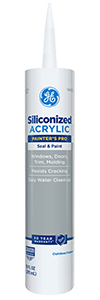Note: This DIY article is provided as a general guide only and is not intended to take the place of product-specific installation procedures; always follow applicable manufacturers’ instructions. Depending on your home’s age and condition, location within the home, and other potential factors, repairs and/or upgrades or other services may be necessary prior to the beginning and/or completion of your project that may involve the services of a home improvement professional. This article does not include advice about local building codes and/or any related inspections.
Caulking trim may seem like a mundane task, easily overshadowed by the grandeur of other home improvement projects. Nevertheless, knowing how to caulk trim is important for the meticulous attention to detail it demands. Done well, trimmed caulk will elevate the overall aesthetic and longevity of your interior spaces.
For example, imagine you’ve painstakingly installed new trim and baseboards and envisioned a seamless transition between wall and molding. However, upon closer inspection, unsightly gaps and imperfections threaten to mar your hard work. Enter caulking, the unsung hero of finishing touches, poised to bridge these gaps and put a professional polish to your efforts.
In this comprehensive guide, we delve into the art of caulking trim, imparting invaluable techniques to achieve flawless results. From selecting the right caulk to mastering application methods, each step holds the key to unlocking the full potential of your home’s interior.
How to apply caulk trim: 11 critical steps
To caulk trim without making a mess, follow these critical steps.
-
Prepare the surface
Before getting started, ensure your canvas is pristine. Take the time to meticulously clean the surface to remove any dust, dirt, or remnants of old caulk. A rag dipped in soapy water works wonders for wiping away imperfections and setting up optimal adhesion for the new caulk.
-
Fill nail holes with spackle
Don’t overlook the importance of addressing nail holes before caulking. Use a high-quality spackling compound to fill these tiny voids, leaving a smooth and seamless finish. Remember, a little spackle goes a long way. Aim for a slightly raised surface to accommodate shrinkage during drying, minimizing the need for additional coats.
-
Choose the right caulk
Choosing the appropriate caulk is essential for your project. Opt for a paintable, white latex caulk suited for interior applications such as Painter’s Pro Siliconized Acrylic Caulk. This versatile option offers ease of use, fast drying times, and compatibility with various materials commonly found in trim and molding installations.
-
Cut the caulk tube at an angle
Achieving precision in caulking begins with meticulous preparation of the caulk tube. Using a razor blade, carefully slice the tip at a 45-degree angle and adjust the opening to control the width of the caulk bead. Applying this deliberate cut facilitates smoother application and affords greater command over the caulk flow, imparting a neat and uniform finish along the joints of trim and molding.
-
Load the caulk gun
Proper loading of the caulking gun should not be overlooked. Begin by securely inserting the caulk tube into the gun, then gently squeeze the trigger until a small amount of caulk emerges from the tip. This initial priming action readies the gun for smooth and consistent dispensing and minimizes interruptions.
-
Apply caulk at a 45-degree angle
The art of caulking hinges on precision and finesse in application technique. Hold the caulking gun at a 45-degree angle to the trim or molding joint, positioning the tip of the tube at the desired starting point. Apply steady pressure to the trigger while smoothly moving the gun along the joint, dispensing a uniform bead of caulk. Taking the time to learn this technique ensures thorough coverage and provides optimal adhesion to the surface.
-
Work in sections
For efficient caulking, break down the project into manageable sections. This approach prevents the caulk from drying prematurely, allowing ample time for smoothing. Complete one section at a time, applying caulk along the joint before moving on to the next. By working systematically, you will create more thorough coverage and maintain consistency throughout the process.
-
Smooth the caulk
Achieving a seamless finish requires careful attention to smoothing the caulk. After application, use a wet cloth or your finger to gently glide along the bead, flattening for even distribution and eliminating excess. This step enhances the finished appearance and encourages optimal adhesion and durability. Take your time to finesse the caulk, refining each joint to perfection for a polished result.
-
Clean up excess caulk
Attention to detail extends to the cleanup phase of caulking. Once you have applied the caulk and smoothed the surface, promptly remove any excess with a damp paper towel. This technique shapes the appearance and prevents unsightly drips or smudges from drying onto adjacent surfaces. By maintaining a clean workspace and meticulously attending to clean up, you ensure a professional-quality finish that stands the test of time.
-
Allow caulk to dry
Patience is key in the final stages of caulking. Allow the caulk to dry completely according to the manufacturer’s instructions before proceeding with painting or further finishing. Rushing this step may compromise the integrity of the caulk and result in subpar adhesion or finish. By waiting out the proper drying times, you guarantee a durable and long-lasting seal that enhances the overall appearance of your trim and molding.
-
Inspect and touch up
Following the manufacturer-suggested drying period, inspect the caulked joints. Pay close attention to detail, identifying any areas requiring further attention or touch-up. Addressing missed spots or imperfections promptly is much easier when handled in a timely fashion. Having patience in this stage guarantees the integrity and visual appeal of the trim and molding throughout your living space.
When caulking trim, opt for high-quality caulking materials to ensure durability and longevity. Acrylic caulks offer excellent flexibility and resistance to moisture, ideal for trim applications.
Upgrade your trim with confidence using high-quality GE caulks. Our paintable latex caulks are engineered for precision, ensuring seamless joints and a professional finish. Trust in our proven reliability for your next trim project.



